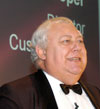As a follow-up to his article the top 10 questions in customer service Paul Cooper looks at ten more frequently asked questions.
1. What should I measure?
The right things, not the easiest things. There are many systems out there today that will literally measure everything that can be measured. But ask yourself – will it get looked at, will it lead to actions being taken, is it really relevant?
There is a current trend in contact centres to take out much of the traditional call time etc. measurements, and results seem to show that productivity and satisfaction go up. There’s a message there somewhere.
The two things that you should always do in some way are to measure employee and customer satisfaction/delight.
But the true question is – are you doing it to give yourself a warm feeling inside, or to see where you have to make changes? You get what you measure, so what are you really trying to achieve?
2. What are the biggest things getting in the way of developing a service excellence culture?
Financial and strategic short-termism and a lack of vision at board level. There is just not enough proper leadership from the top setting out clearly, and living the values of the organisation, communicating these to others, and then galvanising everyone’s efforts around the same objectives.
This is not rocket science but it needs consistent effort and application. People, and particularly front-line people, need to know that the organisation means what it says and they need to feel that they are a full part of the enterprise and that their efforts, skills etc. are recognised.
3. People who are great at customer service are born, not made, aren’t they?
Although there is a certain element of truth in this, as can be demonstrated by psychometric testing, people’s performance can be improved significantly with the right developmental training, improved attitudes to work and their organisation, and constant reinforcement.
There is good evidence that the gaining of formal recognition through a qualification like an NVQ, especially reinforced by membership of a professional body, makes a significant difference to a person’s commitment and attitude to work as a whole, and to their organisation.
The key is hiring for attitude and training for skills.
4. So what constitutes this whole “customer service industry” then?
I believe that there are many ways through which good and bad customer service can be delivered, but these are all sub-processes of customer service, not industries in their own right. Retail/high street, contact centres, CRM, e-Service, help desks, etc. all form part of the whole thing.
Can you think of a job that doesn’t include an element of customer service, internal or external?
5. Where does the customer service message sit with sales and marketing?
It is actually the underlying support to their whole being. With no customers to sell or market to a commercial organisation has little purpose. Great customer word of mouth in many cases can be at least as important as a sales force, and excellent organisations realise that retaining and maximising existing customer loyalty is even more important than gaining new customers.
On the marketing side, for a long time product was “king” and an organisation built its reputation on this. Nowadays there is a growing push for service quality to be recognised as the real builder and retainer of reputation. In the future, switched-on organisations must consider whether the best structure is having sales and marketing reporting to customer service – not the other way around.
6. Is it time we had a customer service director?
Maybe, and, of course, many organisations already do. It depends on what the person will be responsible for, and whether, as a result, everyone else on the board will abrogate their responsibility for customer service to the customer service director.
The important requirement is that any customer service director should have responsibility for internal customer service as well as external, so that processes are aligned and departmental responsibilities are clearly defined. The ultimate customer service director is always the MD/CEO, which is where the real responsibility for customers must lie. It can’t be delegated.
7. How can we tell the world how great we are as an organisation at customer service?
The first point is that you have to be. This is not a product that you can market the hell out of and hope you can get away with it. The customer, internal or external, will see through that one very quickly.
The second point is that you must get your timing right and the external customer must come second, after you’ve got everything right internally. You see, if you increase the customer promise without improving things internally, all you breed is resentment, and this will worsen employee satisfaction and relations, which leads to higher turnover, recruitment problems and disaster.
8. How do I get consistency of service across the whole organisation?
The key is great internal communication linked with an excellent induction and training programme and a culture that encourages empowerment, but sets standards, processes and procedures.
The key phrase is “joined-up” and this also requires consistency in approach to employees. It has been said that the real problem is that employees DO listen to what you tell them, so mixed signals, or no signals at all, lead to problems.
Praising good practice and passing it on is invaluable, and ensuring that all of the support controls, such as processes and procedures, are well known and always up to date is far too rare.
9. How can I get my people to handle out-of-the-ordinary customer situations appropriately when bending the rules a little?
There are of course sometimes regulatory issues here, and these must be taken into consideration. However, the general answer has to be getting them fully on board with the culture and working within a trust, not a fear/blame culture.
If small mistakes are made, this is part of the learning curve, not a reason for chastisement and blame.
Learning from other, more experienced, people through mentoring and coaching is essential, and the development of self-assurance will all lead to them, and you, building confidence. A manager’s job is not to accumulate power, but to develop others.
10. How can I keep my staffing costs down?
Research shows that more than 25% of the annual salaries bill of many organisations goes in advertising for staff, recruitment, temporary labour, induction training, absenteeism, and lost revenue for a missing person.
The short answer therefore lies in reducing this to a minimum, primarily by hiring the right people and then concentrating all efforts on minimising headcount turnover. This should be directed at staff recognition and development programmes in their current jobs so that they will feel engaged and competent, which will almost certainly lead to a major improvement in their discretionary effort.

Paul Cooper
This should then continue to include continuous development programmes that will help determine potential, and a well-thought-out career plan structure. These are all key factors in getting a significant, and permanent improvement in employee satisfaction, and we already know how important that is, don’t we?
Paul A Cooper is a Director of Customer Plus
Do you have any other suggestions? Please leave them
Author: Jo Robinson
Published On: 27th Jul 2011 - Last modified: 15th Aug 2025
Read more about - Customer Service Strategy, Customer Service, Rankings, Service Strategy



















